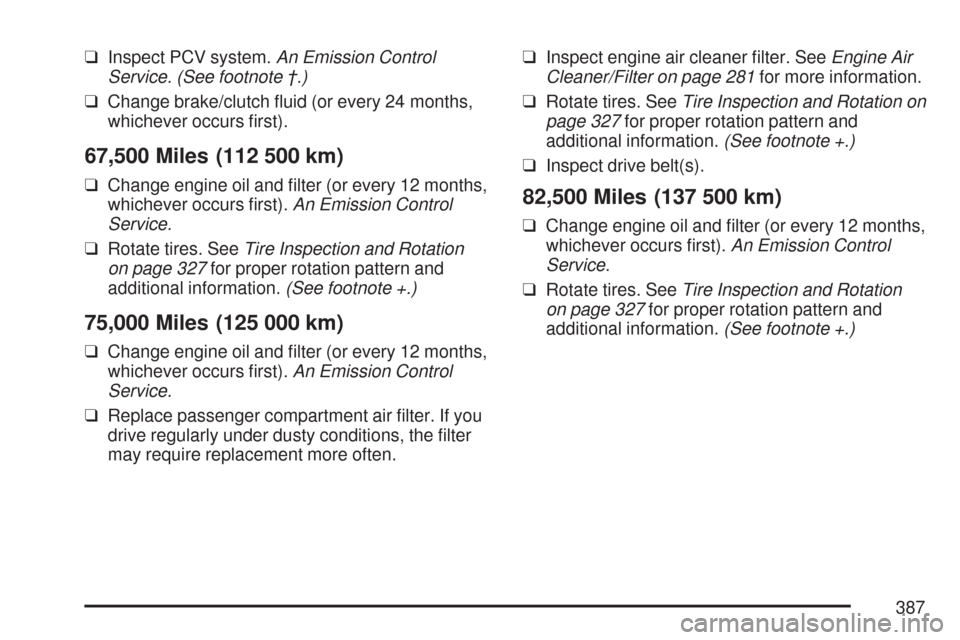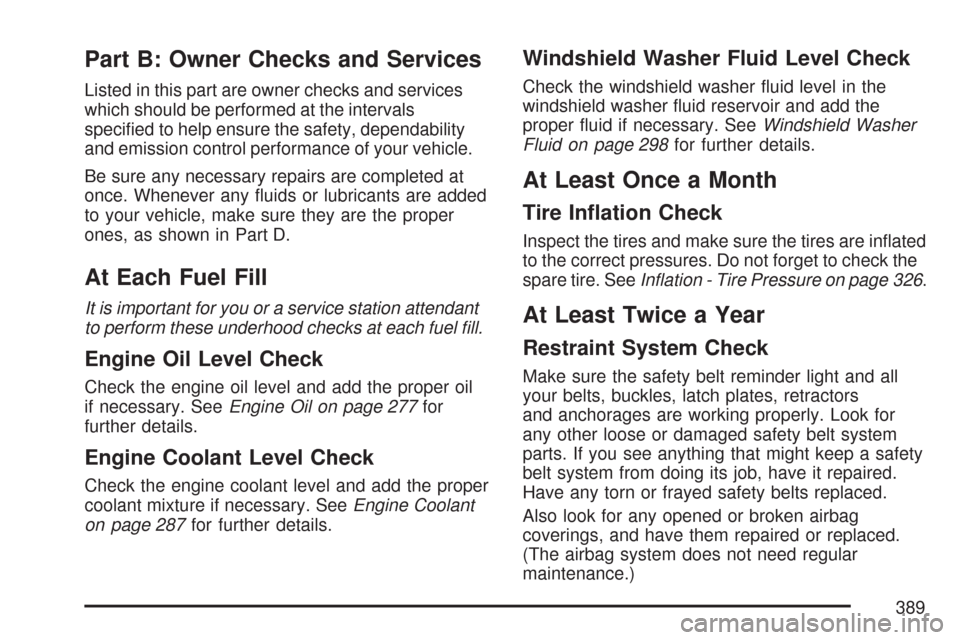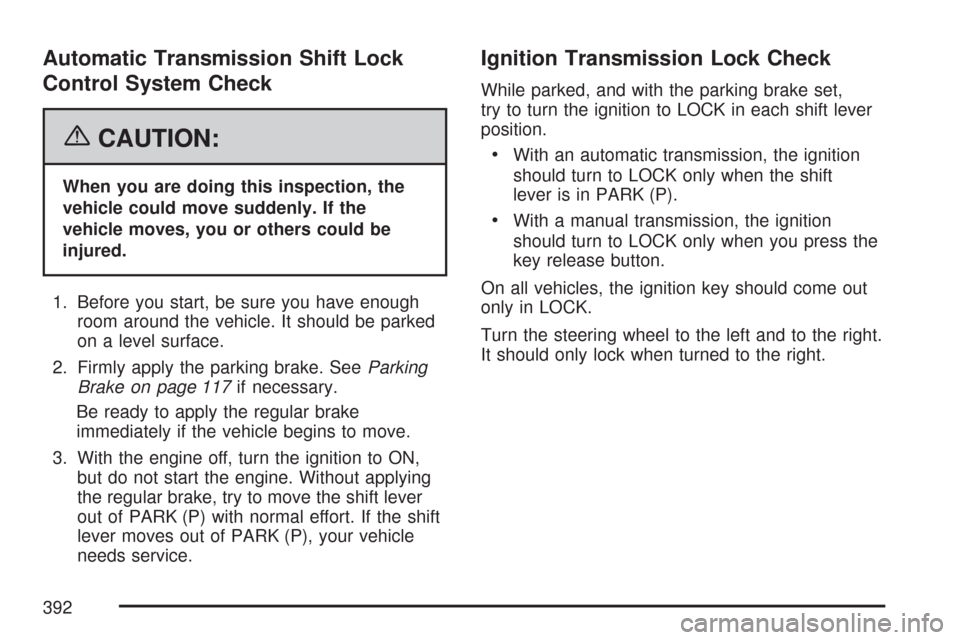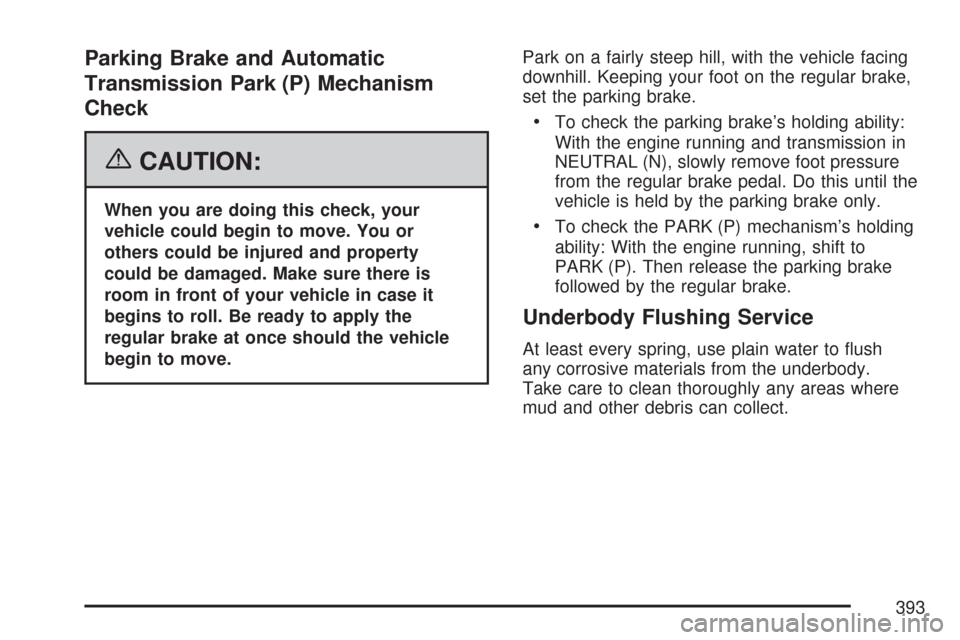Page 386 of 436

45,000 Miles (75 000 km)
❑Change engine oil and filter (or every 12 months,
whichever occurs first).An Emission Control
Service.
❑Replace passenger compartment air filter.
If you drive regularly under dusty conditions,
the filter may require replacement more often.
❑Inspect engine air cleaner filter. SeeEngine Air
Cleaner/Filter on page 281for more information.
❑Rotate tires. SeeTire Inspection and Rotation
on page 327for proper rotation pattern and
additional information.(See footnote +.)
❑Inspect drive belt(s).
52,500 Miles (87 500 km)
❑Change engine oil and filter (or every 12 months,
whichever occurs first).An Emission Control
Service.
❑Rotate tires. SeeTire Inspection and Rotation
on page 327for proper rotation pattern and
additional information.(See footnote +.)
60,000 Miles (100 000 km)
❑Change engine oil and filter (or every 12 months,
whichever occurs first).An Emission Control
Service.
❑Replace passenger compartment air filter. If you
drive regularly under dusty conditions, the filter
may require replacement more often.
❑Replace engine air cleaner filter. SeeEngine Air
Cleaner/Filter on page 281for more information.
❑Rotate tires. SeeTire Inspection and Rotation
on page 327for proper rotation pattern and
additional information.(See footnote +.)
❑Replace spark plugs.An Emission Control
Service.
❑Replace spark plug wires.An Emission Control
Service.
❑Inspect drive belt(s).
❑Replace timing belt.
❑Inspect EVAP canister and vapor lines. Replace
EVAP vent solenoid valve.An Emission Control
Service. (See footnote †.)
386
Page 387 of 436

❑Inspect PCV system.An Emission Control
Service. (See footnote †.)
❑Change brake/clutch fluid (or every 24 months,
whichever occurs first).
67,500 Miles (112 500 km)
❑Change engine oil and filter (or every 12 months,
whichever occurs first).An Emission Control
Service.
❑Rotate tires. SeeTire Inspection and Rotation
on page 327for proper rotation pattern and
additional information.(See footnote +.)
75,000 Miles (125 000 km)
❑Change engine oil and filter (or every 12 months,
whichever occurs first).An Emission Control
Service.
❑Replace passenger compartment air filter. If you
drive regularly under dusty conditions, the filter
may require replacement more often.❑Inspect engine air cleaner filter. SeeEngine Air
Cleaner/Filter on page 281for more information.
❑Rotate tires. SeeTire Inspection and Rotation on
page 327for proper rotation pattern and
additional information.(See footnote +.)
❑Inspect drive belt(s).
82,500 Miles (137 500 km)
❑Change engine oil and filter (or every 12 months,
whichever occurs first).An Emission Control
Service.
❑Rotate tires. SeeTire Inspection and Rotation
on page 327for proper rotation pattern and
additional information.(See footnote +.)
387
Page 388 of 436

90,000 Miles (150 000 km)
❑Change engine oil and filter (or every 12 months,
whichever occurs first).An Emission Control
Service.
❑Replace engine oil pan drain plug washer.
❑Replace passenger compartment air filter. If you
drive regularly under dusty conditions, the filter
may require replacement more often.
❑Replace engine air cleaner filter. SeeEngine Air
Cleaner/Filter on page 281for more information.
❑Rotate tires. SeeTire Inspection and Rotation
on page 327for proper rotation pattern and
additional information.(See footnote +.)
❑Replace spark plugs.An Emission Control
Service.
❑Replace fuel filter.An Emission Control Service.
(See footnote †.)
❑Inspect drive belt(s).
❑Inspect timing belt.
❑Inspect EVAP canister, vapor lines and EVAP
vent solenoid valve.An Emission Control
Service. (See footnote †.)❑Inspect PCV system.An Emission Control
Service. (See footnote †.)
❑Change brake/clutch fluid (or every 24 months,
whichever occurs first).
97,500 Miles (162 500 km)
❑Change engine oil and filter (or every 12 months,
whichever occurs first).An Emission Control
Service.
❑Rotate tires. SeeTire Inspection and Rotation
on page 327for proper rotation pattern and
additional information.(See footnote +.)
150,000 Miles (240 000 km)
❑Drain, flush, and refill cooling system.
This service can be complex; you should
have your dealer/retailer perform this service.
SeeEngine Coolant on page 287for what
to use. Inspect hoses. Clean radiator,
condenser, pressure cap, and neck. Pressure
test the cooling system and pressure cap.
An Emission Control Service.
388
Page 389 of 436

Part B: Owner Checks and Services
Listed in this part are owner checks and services
which should be performed at the intervals
specified to help ensure the safety, dependability
and emission control performance of your vehicle.
Be sure any necessary repairs are completed at
once. Whenever any fluids or lubricants are added
to your vehicle, make sure they are the proper
ones, as shown in Part D.
At Each Fuel Fill
It is important for you or a service station attendant
to perform these underhood checks at each fuel fill.
Engine Oil Level Check
Check the engine oil level and add the proper oil
if necessary. SeeEngine Oil on page 277for
further details.
Engine Coolant Level Check
Check the engine coolant level and add the proper
coolant mixture if necessary. SeeEngine Coolant
on page 287for further details.
Windshield Washer Fluid Level Check
Check the windshield washer fluid level in the
windshield washer fluid reservoir and add the
proper fluid if necessary. SeeWindshield Washer
Fluid on page 298for further details.
At Least Once a Month
Tire In�ation Check
Inspect the tires and make sure the tires are inflated
to the correct pressures. Do not forget to check the
spare tire. SeeInflation - Tire Pressure on page 326.
At Least Twice a Year
Restraint System Check
Make sure the safety belt reminder light and all
your belts, buckles, latch plates, retractors
and anchorages are working properly. Look for
any other loose or damaged safety belt system
parts. If you see anything that might keep a safety
belt system from doing its job, have it repaired.
Have any torn or frayed safety belts replaced.
Also look for any opened or broken airbag
coverings, and have them repaired or replaced.
(The airbag system does not need regular
maintenance.)
389
Page 391 of 436
Starter Switch Check
{CAUTION:
When you are doing this inspection, the
vehicle could move suddenly. If the
vehicle moves, you or others could be
injured.
1. Before you start, be sure you have enough
room around the vehicle.
2. Firmly apply both the parking brake and the
regular brake. SeeParking Brake on page 117
if necessary.
Do not use the accelerator pedal, and be
ready to turn off the engine immediately if
it starts.3. On automatic transmission vehicles, try to
start the engine in each gear. The starter
should work only in PARK (P) or
NEUTRAL (N). If the starter works in any
other position, your vehicle needs service.
On manual transmission vehicles, put the shift
lever in NEUTRAL, push the clutch pedal
down halfway and try to start the engine.
The starter should work only when the clutch
pedal is pushed down all the way to the
floor. If the starter works when the clutch pedal
is not pushed all the way down, your vehicle
needs service.
391
Page 392 of 436

Automatic Transmission Shift Lock
Control System Check
{CAUTION:
When you are doing this inspection, the
vehicle could move suddenly. If the
vehicle moves, you or others could be
injured.
1. Before you start, be sure you have enough
room around the vehicle. It should be parked
on a level surface.
2. Firmly apply the parking brake. SeeParking
Brake on page 117if necessary.
Be ready to apply the regular brake
immediately if the vehicle begins to move.
3. With the engine off, turn the ignition to ON,
but do not start the engine. Without applying
the regular brake, try to move the shift lever
out of PARK (P) with normal effort. If the shift
lever moves out of PARK (P), your vehicle
needs service.
Ignition Transmission Lock Check
While parked, and with the parking brake set,
try to turn the ignition to LOCK in each shift lever
position.
•With an automatic transmission, the ignition
should turn to LOCK only when the shift
lever is in PARK (P).
•With a manual transmission, the ignition
should turn to LOCK only when you press the
key release button.
On all vehicles, the ignition key should come out
only in LOCK.
Turn the steering wheel to the left and to the right.
It should only lock when turned to the right.
392
Page 393 of 436

Parking Brake and Automatic
Transmission Park (P) Mechanism
Check
{CAUTION:
When you are doing this check, your
vehicle could begin to move. You or
others could be injured and property
could be damaged. Make sure there is
room in front of your vehicle in case it
begins to roll. Be ready to apply the
regular brake at once should the vehicle
begin to move.Park on a fairly steep hill, with the vehicle facing
downhill. Keeping your foot on the regular brake,
set the parking brake.
•To check the parking brake’s holding ability:
With the engine running and transmission in
NEUTRAL (N), slowly remove foot pressure
from the regular brake pedal. Do this until the
vehicle is held by the parking brake only.
•To check the PARK (P) mechanism’s holding
ability: With the engine running, shift to
PARK (P). Then release the parking brake
followed by the regular brake.
Underbody Flushing Service
At least every spring, use plain water to flush
any corrosive materials from the underbody.
Take care to clean thoroughly any areas where
mud and other debris can collect.
393
Page 394 of 436

Part C: Periodic Maintenance
Inspections
Listed in this part are inspections and services
which should be performed at least twice a year,
for instance, each spring and fall.You should
let your dealer/retailer do these jobs. Make sure
any necessary repairs are completed at once.
Proper procedures to perform these services can
be found in a service manual. SeeService
Publications Ordering Information on page 420.
Steering, Suspension and Front
Drive Axle Boot and Seal Inspection
Inspect the front and rear suspension and
steering system for damaged, loose or missing
parts, signs of wear or lack of lubrication. Inspect
the power steering lines and hoses for proper
hook-up, binding, leaks, cracks, chafing, etc.
Clean and then inspect the drive axle boot seals
for damage, tears or leakage. Replace seals
if necessary.
Exhaust System Inspection
Inspect the complete exhaust system. Inspect the
body near the exhaust system. Look for broken,
damaged, missing, or out-of-position parts as well
as open seams, holes, loose connections, or
other conditions which could cause a heat build-up
in the floor pan or could let exhaust fumes into
the vehicle. SeeEngine Exhaust on page 122.
394